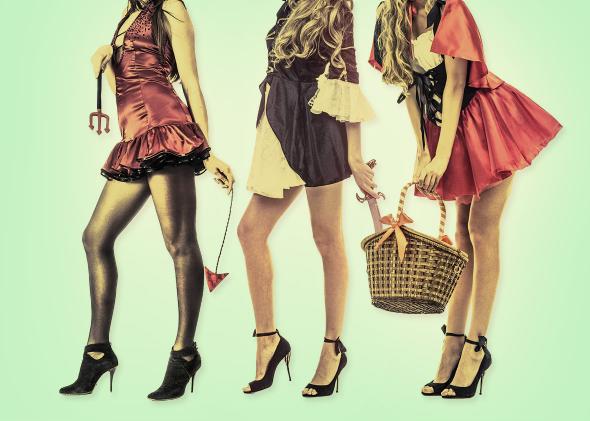Should the Explainer dress as a sexy Neytiri this Halloween? Or maybe go for something classic, like a naughty nurse? No, wait, maybe a slutty French maid? Halloween provides an excellent opportunity for young women, and also men, and also not-so-young women, to go out in very little clothing. When did sexy costumes become the norm?
In the 1970s. Costuming has been a part of Halloween since at least the 19th century, when Scottish and Irish children went “guising” house-to-house in exchange for coins. The Victorians enjoyed a good costume ball on Halloween, and some daring getups, like Gypsy outfits, were popular. But risqué costumes were not pervasive until right around Gerald Ford’s presidency, when gay communities in the United States adopted Halloween as an occasion for revealing, over-the-top attire.
The Halloween parade in New York City’s Greenwich Village began in 1973 as a family-and-friends promenade from house-to-house organized by a local puppeteer and mask-maker. It quickly became a neighborhoodwide party, however, and since the Village was New York’s de facto gay district, the gay community cottoned to it. The event, with its drag outfits and otherwise rebellious costuming, became famous in New York and across the country, as did similarly bawdy Halloween parties in San Francisco’s Castro neighborhood and in West Hollywood.
Gay communities planted the seed, then retailers did the rest of the work, capitalizing on the spirit of these parades with readymade sexy outfits that got skimpier from year to year. A 2006 New York Times article quotes the purchasing director for BuyCostumes.com as saying that “ultra sexy” costumes emerged in the early aughts, with products like the Little Bo “Peep Show” outfit.
The popularity of “ultra sexy” wear does not merely reflect the 1970s drag-queen spirit but the more general skimpification of America. As Halloween historian Lesley Bannatyne told the Explainer, Halloween is a “rogue” holiday not connected to a historical person or a historical event, so celebrants are free to express whatever’s in the air at that particular moment—with bed intruder costumes and the like—as well as more general trends. Our culture is more into revealed-cleavage than it once was, so it makes sense that Halloween has kept apace (in a parodic, pushing-the-envelope sort of way) despite the fact that Oct. 31 is often rather cold in much of the country.
Got a question about today’s news? Ask the Explainer.
Explainer thanks Lesley Bannatyne, Lisa Morton, and Nicholas Rogers of York University.
